The Impact of a Multitasking-Based Virtual Reality Motion Video Game on the Cognitive and Physical Abilities of Older Adults
Abstract
1. Introduction
2. Materials and Methods
2.1. Motion Video Game
2.1.1. Gameplay
2.1.2. Multitasking
2.1.3. Playing procedure
2.2. Experimental Design
2.2.1. Participants
2.2.2. Procedure
2.2.3. Metrics
3. Results
3.1. Cognitive Assessment
3.1.1. Working Memory (n-back)
3.1.2. Reasoning (SPM)
3.1.3. Attention (ANT)
3.2. Physical Assessment
Balance (OLSBT)
3.3. Player Experience (PX)
3.3.1. IMI and PENS
3.3.2. IMI and Cognitive Enhancement
3.3.3. PANAS and Physical Enhancement
3.3.4. Participant Feedback
4. Discussion
Author Contributions
Funding
Acknowledgments
Conflicts of Interest
References
- Altschul, D.M.; Deary, I.J. Playing Analog Games Is Associated With Reduced Declines in Cognitive Function: A 68-Year Longitudinal Cohort Study. J. Gerontol. B Psychol. Sci. Soc. Sci. 2019, 75, 474–482. [Google Scholar] [CrossRef] [PubMed]
- Lee, H.K.; Kent, J.D.; Wendel, C.; Wolinsky, F.D.; Foster, E.D.; Merzenich, M.M.; Voss, M.W. Home-Based, Adaptive Cognitive Training for Cognitively Normal Older adults: Initial Efficacy Trial. J. Gerontol. B Psychol. Sci. Soc. Sci. 2019, 75, 1144–1154. [Google Scholar] [CrossRef]
- Nouchi, R.; Taki, Y.; Takeuchi, H.; Akitsuki, Y.; Shigemune, Y.; Sekiguchi, A.; Kotozaki, Y.; Tsukiura, T.; Yomogida, Y. Brain training game improves executive functions and processing speed in the elderly: A randomized controlled trial. PLoS ONE 2012, 7, e29676. [Google Scholar] [CrossRef] [PubMed]
- Anguera, J.A.; Boccanfuso, J.; Rintoul, J.L.; Al-Hashimi, O.; Faraji, F.; Janowich, J.; Kong, E.; Larraburo, Y.; Rolle, C.; Johnston, E. Video game training enhances cognitive control in older adults. Nature 2013, 501, 97–101. [Google Scholar] [CrossRef] [PubMed]
- Delbridge, K.A. Individual Differences in Multi-Tasking Ability: Exploring a Nomological Network. Unpublished Doctoral Dissertation, Michigan State University, East Lansing, USA, 2000. Available online: https://www.researchgate.net/publication/33710097 (accessed on 31 October 2020).
- Colom, R.; Martínez-Molina, A.; Shih, P.C.; Santacreu, J. Intelligence, working memory, and multitasking performance. Intelligence 2010, 38, 543–551. [Google Scholar] [CrossRef]
- Konig, C.J.; Buhner, M.; Murling, G. Working memory, fluid intelligence, and attention are predictors of multitasking performance, but polychronicity and extraversion are not. Hum. Perform. 2005, 18, 243–266. [Google Scholar] [CrossRef]
- Bherer, L.; Langeard, A.; Kaushal, N.; Vrinceanu, T.; Desjardins-crépeau, L.; Langlois, F.; Kramer, A.F. Physical Exercise Training Effect and Mediation Through Cardiorespiratory Fitness on Dual-Task Performances Differ in Younger—Old and Older—Old Adults. J. Gerontol. B Psychol. Sci. Soc. Sci. 2019, gbz66. [Google Scholar] [CrossRef] [PubMed]
- Chapman, S.B.; Aslan, S.; Spence, J.S.; DeFina, L.F.; Keebler, M.W.; Didehbani, N.; Lu, H. Shorter term aerobic exercise improves brain, cognition, and cardiovascular fitness in aging. Front. Aging Neurosci. 2013, 5, 75. [Google Scholar] [CrossRef]
- Wayne, P.M.; Walsh, J.N.; Taylor-Piliae, R.E.; Wells, R.E.; Papp, K.V.; Donovan, N.J.; Yeh, G.Y. Effect of Tai Chi on cognitive performance in older adults: Systematic review and meta-analysis. J. Am. Geriatr. Soc. 2014, 62, 25–39. [Google Scholar] [CrossRef] [PubMed]
- Besombes, N.; Maillot, P. Body Involvement in Video Gaming as a Support for Physical and Cognitive Learning. Games Cult. 2020, 15, 565–584. [Google Scholar] [CrossRef]
- Lauenroth, A.; Ioannidis, A.E.; Teichmann, B. Influence of combined physical and cognitive training on cognition: A systematic review. BMC Geriatr. 2016, 16, 141. [Google Scholar] [CrossRef] [PubMed]
- Stojan, R.; Voelcker-Rehage, C. A Systematic Review on the Cognitive Benefits and Neurophysiological Correlates of Exergaming in Healthy Older Adults. J. Clin. Med. 2019, 8, 734. [Google Scholar] [CrossRef] [PubMed]
- Zhu, X.; Yin, S.; Lang, M.; He, R.; Li, J. The more the better? A meta-analysis on effects of combined cognitive and physical intervention on cognition in healthy older adults. Ageing Res. Rev. 2016, 31, 67–79. [Google Scholar] [CrossRef] [PubMed]
- Barcelos, N.; Shah, N.; Cohen, K.; Hogan, M.J.; Mulkerrin, E.; Arciero, P.J.; Cohen, B.D.; Kramer, A.F.; Anderson-Hanley, C. Aerobic and Cognitive Exercise (ACE) pilot study for older adults: Executive function improves with cognitive challenge while exergaming. JINS J. Int. Neuropsychol. Soc. 2015, 21, 768. [Google Scholar] [CrossRef]
- Monteiro-Junior, R.S.; Vaghetti, C.A.O.; Nascimento, O.J.M.; Laks, J.; Deslandes, A.C. Exergames: Neuroplastic hypothesis about cognitive improvement and biological effects on physical function of institutionalized older persons. Neural Regener. Res. 2016, 11, 201–204. [Google Scholar] [CrossRef]
- Kayama, H.; Okamoto, K.; Nishiguchi, S.; Yamada, M.; Kuroda, T.; Aoyama, T. Effect of a Kinect-based exercise game on improving executive cognitive performance in community-dwelling elderly: Case control study. J. Med Internet Res. 2014, 16, e61. [Google Scholar] [CrossRef]
- Guimarães, A.V.; Barbosa, A.R.; Meneghini, V. Active videogame-based physical activity vs. aerobic exercise and cognitive performance in older adults: A randomized controlled trial. J. Phys. Educ. Sport 2018, 18, 203–209. Available online: http://efsupit.ro/images/stories/martie2018/Art%2026.pdf (accessed on 31 October 2020).
- Maillot, P.; Perrot, A.; Hartley, A. Effects of interactive physical-activity video-game training on physical and cognitive function in older adults. Psychol. Aging 2012, 27, 589–600. [Google Scholar] [CrossRef]
- Eggenberger, P.; Schumacher, V.; Angst, M.; Theill, N.; de Bruin, E.D. Does multicomponent physical exercise with simultaneous cognitive training boost cognitive performance in older adults? A 6-month randomized controlled trial with a 1-year follow-up. Clin. Interv. Aging 2015, 10, 1335–1349. [Google Scholar] [CrossRef]
- García-Betances, R.I.; Arredondo Waldmeyer, M.T.; Fico, G.; Cabrera-Umpiérrez, M.F. A succinct overview of virtual reality technology use in Alzheimer’s disease. Front. Aging Neurosci. 2015, 7, 80. [Google Scholar] [CrossRef]
- Laver, K.; George, S.; Thomas, S.; Deutsch, J.E.; Crotty, M. Cochrane review: Virtual reality for stroke rehabilitation. Eur. J. Phys. Rehabil. Med. 2012, 48, 523–530. [Google Scholar] [CrossRef]
- Tan, C.T.; Leong, T.W.; Shen, S.; Dubravs, C.; Si, C. Exploring gameplay experiences on the Oculus Rift. In Proceedings of the 2015 Annual Symposium on Computer-Human Interaction in Play, London, UK, 5–7 October 2015; pp. 253–263. [Google Scholar] [CrossRef]
- Shelstad, W.J.; Smith, D.C.; Chaparro, B.S. Gaming on the rift: How virtual reality affects game user satisfaction. Proc. Hum. Factors Ergon. Soc. Annu. Meet. 2017, 61, 2072–2076. [Google Scholar] [CrossRef]
- Anderson-Hanley, C.; Arciero, P.J.; Brickman, A.M.; Nimon, J.P.; Okuma, N.; Westen, S.C.; Merz, M.E.; Pence, B.D.; Woods, J.A.; Kramer, A.F. Exergaming and older adult cognition: A cluster randomized clinical trial. Am. J. Prev. Med. 2012, 42, 109–119. [Google Scholar] [CrossRef] [PubMed]
- Huang, K.-T. Exergaming executive functions: An immersive virtual reality-based cognitive training for adults aged 50 and older. Cyberpsychol. Behav. Soc. Netw. 2019, 23, 143–149. [Google Scholar] [CrossRef] [PubMed]
- Salehzadeh Niksirat, K.; Silpasuwanchai, C.; Ren, X.; Wang, Z. Towards cognitive enhancement of the elderly: A ux study of a multitasking motion video game. In Proceedings of the 2017 CHI Conference Extended Abstracts on Human Factors in Computing Systems, Denver, CO, USA, 6–11 May 2017; pp. 2017–2024. [Google Scholar] [CrossRef]
- Baddeley, A. Working memory. Science 1992, 255, 556–559. [Google Scholar] [CrossRef]
- Baddeley, A.D.; Hitch, G. Working memory. Psychol. Learn. Motiv. 1974, 8, 47–89. [Google Scholar] [CrossRef]
- Susanne, M.J.; Martin, J.; Walter, J.P.; Beat, M. The concurrent validity of the N-back task as a working memory measure. Memory 2010, 18, 394–412. [Google Scholar] [CrossRef]
- Heinzel, S.; Schulte, S.; Onken, J.; Duong, Q.L.; Riemer, T.G.; Heinz, A.; Kathmann, N.; Rapp, M.A. Working memory training improvements and gains in non-trained cognitive tasks in young and older adults. Aging Neuropsychol. Cogn. 2014, 21, 146–173. [Google Scholar] [CrossRef]
- Burke, H.R. Raven’s Progressive Matrices: Validity, Reliability, and Norms. J. Psychol. 1972, 82, 253–257. [Google Scholar] [CrossRef]
- Raven, J.H. Raven, J.H. Raven Progressive Matrices. In Handbook of Nonverbal Assessment; Springer: Boston, MA, USA, 2003; Available online: https://link.springer.com/chapter/10.1007%2F978-1-4615-0153-4_11 (accessed on 31 October 2020).
- Kaplan, R.M.; Saccuzzo, D.P. Standardized tests in education, civil service, and the military. Psychol. Test. Princ. Appl. 2009, 7, 325–327. Available online: https://books.google.co.jp/books?id=4TIeNj-MlrsC&dq=Psychological+Testing:+Principles,+Applications,+and+Issues+2009+7&hl=zhCN&source=gbs_navlinks_s (accessed on 31 October 2020).
- Harada, C.N.; Love, M.C.N.; Triebel, K.L. Normal cognitive aging. Clin. Geriatr. Med. 2013, 29, 737–752. [Google Scholar] [CrossRef]
- Fan, J.; McCandliss, B.D.; Sommer, T.; Raz, A.; Posner, M.I. Testing the efficiency and independence of attentional networks. J. Cogn. Neurosci. 2002, 14, 340–347. [Google Scholar] [CrossRef]
- MacLeod, J.W.; Lawrence, M.A.; McConnell, M.M.; Eskes, G.A.; Klein, R.M.; Shore, D.I. Appraising the ANT: Psychometric and theoretical considerations of the Attention Network Test. Neuropsychology 2010, 24, 637. [Google Scholar] [CrossRef] [PubMed]
- Westlye, L.T.; Grydeland, H.; Walhovd, K.B.; Fjell, A.M. Associations between Regional Cortical Thickness and Attentional Networks as Measured by the Attention Network Test. Cereb. Cortex 2011, 21, 345–356. [Google Scholar] [CrossRef]
- Vellas, B.J.; Wayne, S.J.; Romero, L.; Baumgartner, R.N.; Rubenstein, L.Z.; Garry, P.J. One-leg balance is an important predictor of injurious falls in older persons. J. Am. Geriatr. Soc. 1997, 45, 735–738. [Google Scholar] [CrossRef] [PubMed]
- Bohannon, R.W.; Larkin, P.A.; Cook, A.C.; Gear, J.; Singer, J. Decrease in timed balance test scores with aging. Phys. Ther. 1984, 64, 1067–1070. [Google Scholar] [CrossRef] [PubMed]
- Briggs, R.C.; Gossman, M.R.; Birch, R.; Drews, J.E.; Shaddeau, S.A. Balance performance among noninstitutionalized elderly women. Phys. Ther. 1989, 69, 748–756. [Google Scholar] [CrossRef]
- Vellas, B.J.; Rubenstein, L.Z.; Ousset, P.J.; Faisant, C.; Kostek, V.; Nourhashemi, F.; Allard, M.; Albarede, J.L. One-leg standing balance and functional status in a population of 512 community-living elderly persons. Aging Clin. Exp. Res. 1997, 9, 95–98. [Google Scholar] [CrossRef]
- Watson, D.; Clark, L.A. The PANAS-X: Manual for the Positive and Negative Affect Schedule-Expanded Form; University of Iowa: Iowa City, IA, USA, 1994. [Google Scholar] [CrossRef]
- Ryan, R.M. Control and information in the intrapersonal sphere: An extension of cognitive evaluation theory. J. Personal. Soc. Psychol. 1982, 43, 450–461. [Google Scholar] [CrossRef]
- Ryan, R.M.; Rigby, C.S.; Przybylski, A. The motivational pull of video games: A self-determination theory approach. Motiv. Emot. 2006, 30, 344–360. [Google Scholar] [CrossRef]
- Deci, E.L.; Ryan, R.M. The “what” and “why” of goal pursuits: Human needs and the self-determination of behavior. Psychol. Inq. 2000, 11, 227–268. Available online: https://www.tandfonline.com/doi/abs/10.1207/S15327965PLI1104_01 (accessed on 31 October 2020). [CrossRef]
- Faul, F.; Erdfelder, E.; Buchner, A.; Lang, A.-G. Statistical power analyses using G* Power 3.1: Tests for correlation and regression analyses. Behav. Res. Methods 2009, 41, 1149–1160. [Google Scholar] [CrossRef]
- Diamond, A. Executive Functions. Annu. Rev. Psychol. 2013, 64, 135–168. [Google Scholar] [CrossRef] [PubMed]
- Schoene, D.; Valenzuela, T.; Toson, B.; Delbaere, K.; Severino, C.; Garcia, J.; Davies, T.A.; Russell, F.; Smith, S.T.; Lord, S.R. Interactive cognitive-motor step training improves cognitive risk factors of falling in older adults—A randomized controlled trial. PLoS ONE 2015, 10, e0145161. [Google Scholar] [CrossRef]
- Schoene, D.; Lord, S.R.; Delbaere, K.; Severino, C.; Davies, T.A.; Smith, S.T. A Randomized Controlled Pilot Study of Home-Based Step Training in Older People Using Videogame Technology. PLoS ONE 2013, 8, e57734. [Google Scholar] [CrossRef] [PubMed]
- Van het Reve, E.; de Bruin, E.D. Strength-balance supplemented with computerized cognitive training to improve dual task gait and divided attention in older adults: A multicenter randomized-controlled trial. BMC Geriatr. 2014, 14, 134. [Google Scholar] [CrossRef] [PubMed]
- Kayama, H.; Okamoto, K.; Nishiguchi, S.; Yukutake, T.; Tanigawa, T.; Nagai, K.; Yamada, M.; Aoyama, T. Efficacy of an Exercise Game Based on Kinect in Improving Physical Performances of Fall Risk Factors in Community-Dwelling Older Adults. Games Health J. 2013, 2, 247–252. [Google Scholar] [CrossRef] [PubMed]
- Cho, K.H.; Lee, K.J.; Song, C.H. Virtual-Reality Balance Training with a Video-Game System Improves Dynamic Balance in Chronic Stroke Patients. Tohoku J. Exp. Med. 2012, 228, 69–74. [Google Scholar] [CrossRef]
- Rendon, A.A.; Lohman, E.B.; Thorpe, D.; Johnson, E.G.; Medina, E.; Bradley, B. The effect of virtual reality gaming on dynamic balance in older adults. Age Ageing 2012, 41, 549–552. [Google Scholar] [CrossRef]
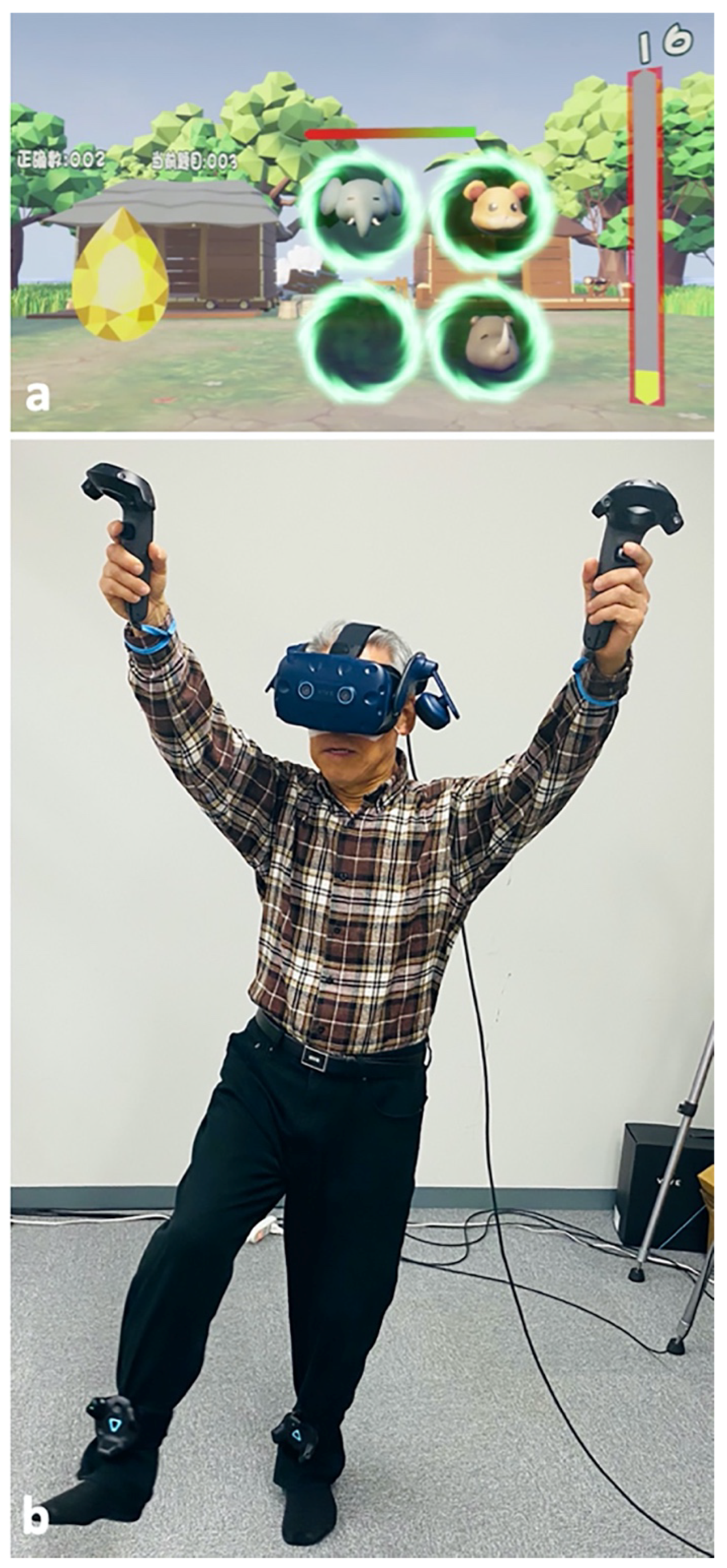
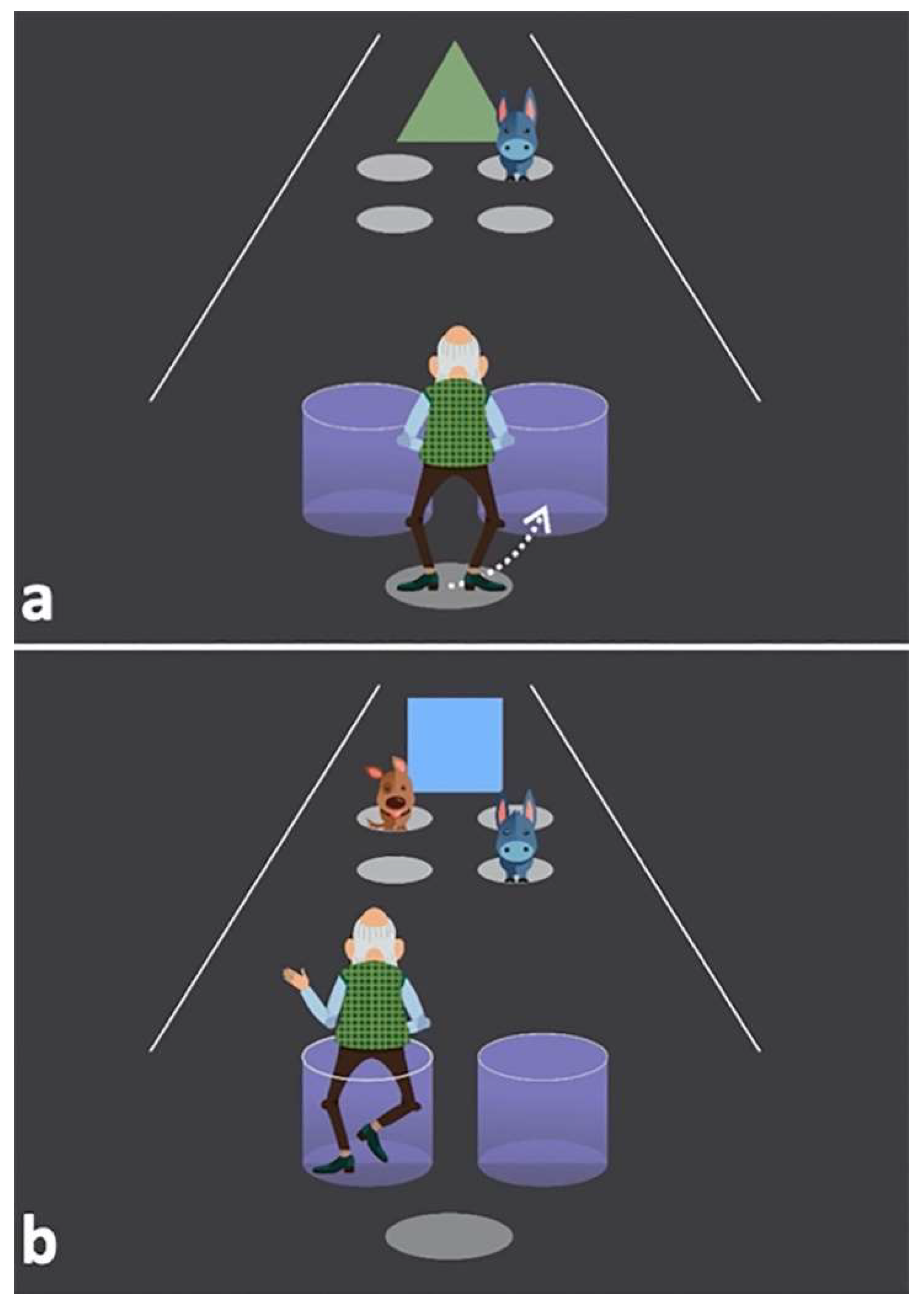
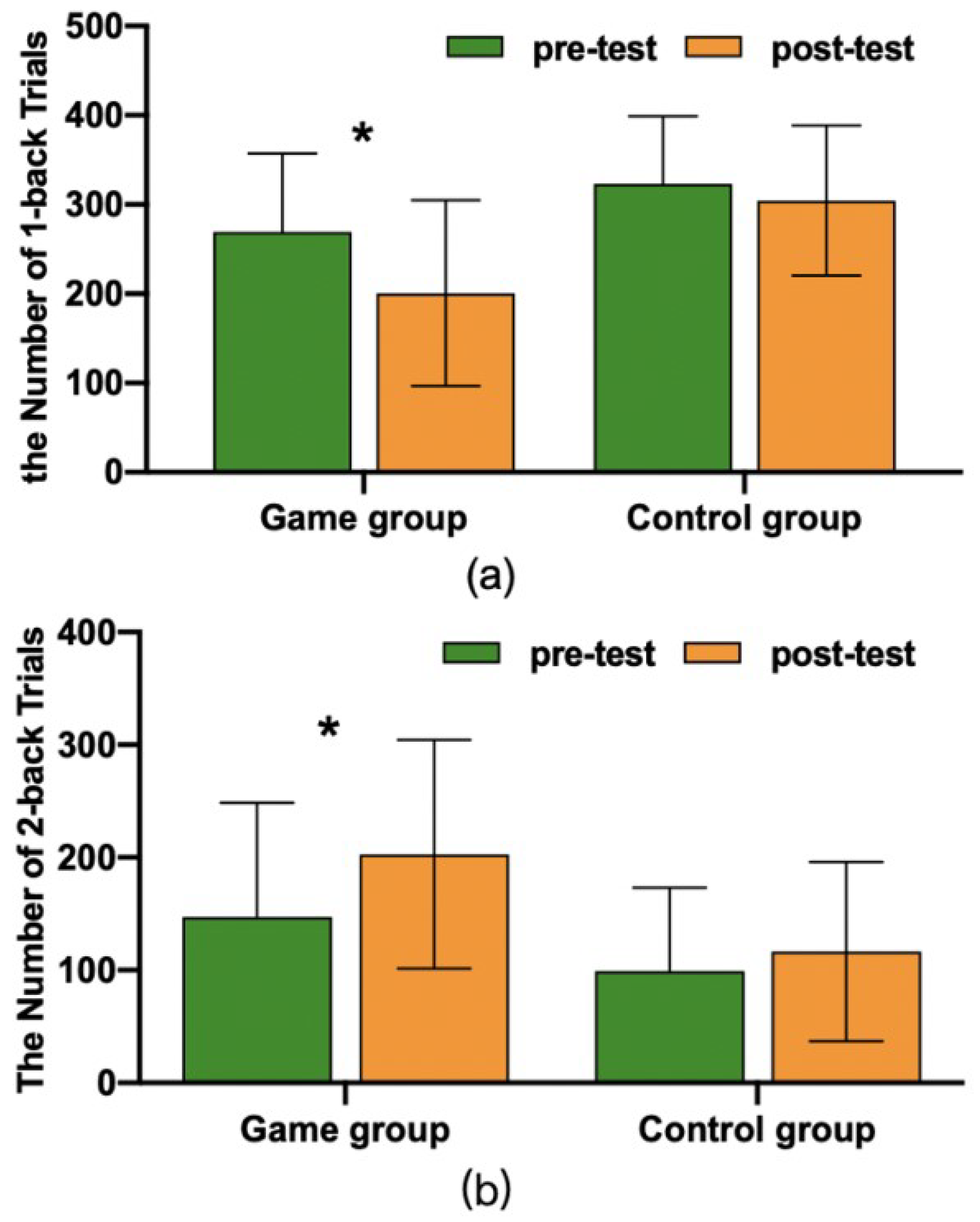
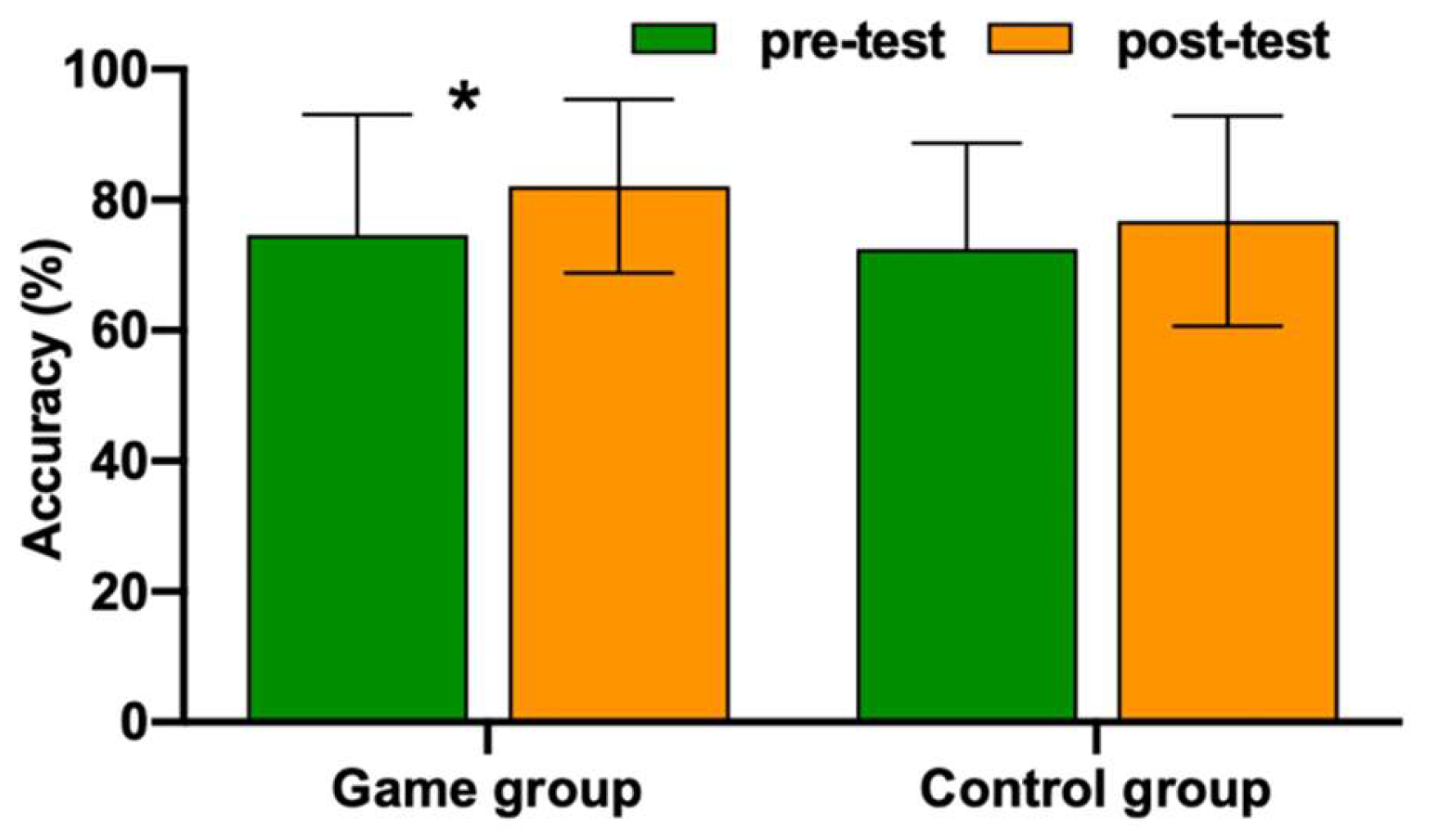
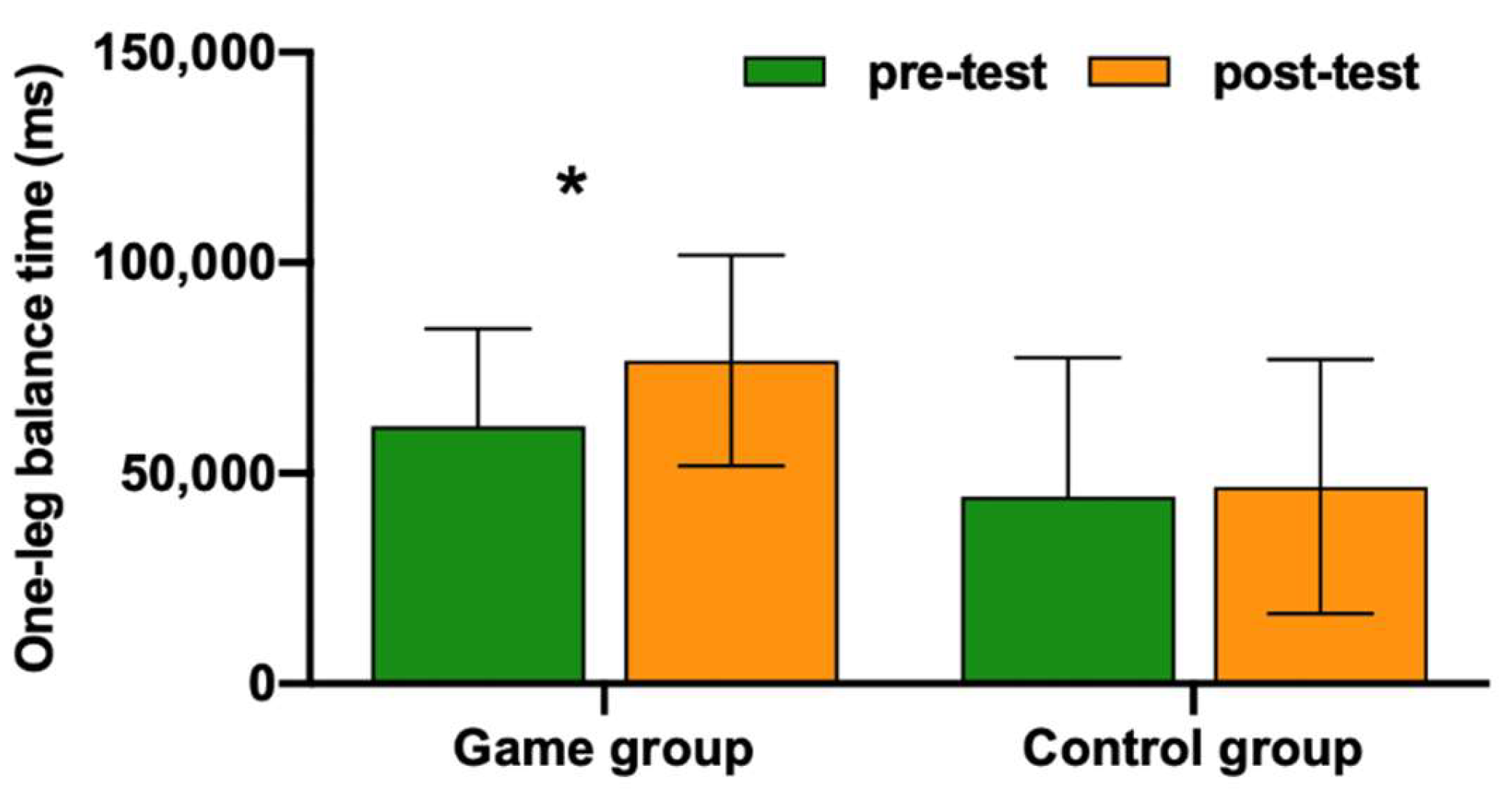
Publisher’s Note: MDPI stays neutral with regard to jurisdictional claims in published maps and institutional affiliations. |
© 2020 by the authors. Licensee MDPI, Basel, Switzerland. This article is an open access article distributed under the terms and conditions of the Creative Commons Attribution (CC BY) license (http://creativecommons.org/licenses/by/4.0/).
Share and Cite
Li, X.; Niksirat, K.S.; Chen, S.; Weng, D.; Sarcar, S.; Ren, X. The Impact of a Multitasking-Based Virtual Reality Motion Video Game on the Cognitive and Physical Abilities of Older Adults. Sustainability 2020, 12, 9106. https://doi.org/10.3390/su12219106
Li X, Niksirat KS, Chen S, Weng D, Sarcar S, Ren X. The Impact of a Multitasking-Based Virtual Reality Motion Video Game on the Cognitive and Physical Abilities of Older Adults. Sustainability. 2020; 12(21):9106. https://doi.org/10.3390/su12219106
Chicago/Turabian StyleLi, Xiaoxuan, Kavous Salehzadeh Niksirat, Shanshan Chen, Dongdong Weng, Sayan Sarcar, and Xiangshi Ren. 2020. "The Impact of a Multitasking-Based Virtual Reality Motion Video Game on the Cognitive and Physical Abilities of Older Adults" Sustainability 12, no. 21: 9106. https://doi.org/10.3390/su12219106
APA StyleLi, X., Niksirat, K. S., Chen, S., Weng, D., Sarcar, S., & Ren, X. (2020). The Impact of a Multitasking-Based Virtual Reality Motion Video Game on the Cognitive and Physical Abilities of Older Adults. Sustainability, 12(21), 9106. https://doi.org/10.3390/su12219106




